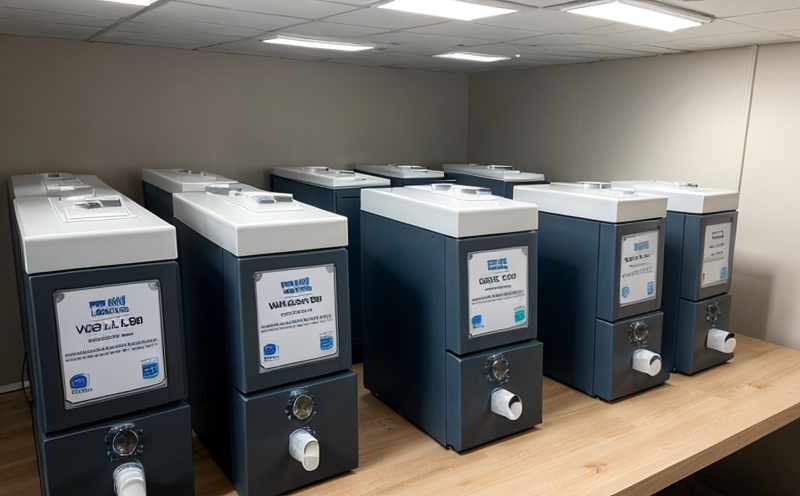ISO 16000-6 Indoor air Analysis of volatile organic compounds by GC MS
The European standard ISO 16000-6 provides a comprehensive method for analyzing volatile organic compounds (VOCs) in indoor air using gas chromatography-mass spectrometry (GC-MS). This methodology is widely recognized and utilized across various sectors, including construction, manufacturing, healthcare, and residential environments. VOCs are a diverse group of chemicals that can have adverse effects on human health if present at high concentrations. The ISO 16000-6 protocol ensures accurate measurement of these compounds to maintain air quality standards.
The testing process involves the collection of indoor air samples, typically using sorbent tubes or passive samplers. These devices are exposed for a specified period and then transported to the laboratory for analysis. The collected VOCs are desorbed from the sampling device and introduced into the GC-MS system through an injection port.
The gas chromatograph separates the individual components of the mixture, while the mass spectrometer identifies them by measuring their molecular weights. This dual approach ensures precise identification and quantification of each compound detected in the sample. The results are presented as concentration levels for various VOCs in parts per million (ppm) or micrograms per cubic meter (μg/m³).
The ISO 16000-6 protocol is particularly useful for identifying common indoor air pollutants such as formaldehyde, benzene, toluene, xylenes, and other aromatic hydrocarbons. It also helps in detecting solvents used in cleaning products or paints, which can significantly affect the quality of indoor air.
For accurate results, it is crucial that samples are collected under controlled conditions and stored appropriately before analysis. Proper specimen preparation involves desorption techniques tailored to each type of VOC, ensuring no contamination during sample handling. The use of high-quality instruments like GC-MS guarantees reliable data interpretation.
The significance of this testing cannot be overstated, especially in environments where human health is paramount. By adhering to ISO 16000-6 guidelines, industries can ensure compliance with international standards and provide safer indoor spaces for workers and occupants. Regular monitoring using this method helps maintain air quality standards and mitigate potential risks associated with prolonged exposure to harmful VOCs.
Understanding the composition of indoor air is essential not only for regulatory purposes but also for improving ventilation systems, selecting appropriate building materials, and enhancing overall comfort levels within confined spaces. The insights gained from ISO 16000-6 enable informed decisions about mitigation strategies aimed at reducing adverse health impacts linked to poor indoor air quality.
Benefits
The implementation of ISO 16000-6 Indoor air Analysis by GC MS offers numerous advantages across multiple sectors. For construction and real estate developers, this method ensures compliance with regulatory requirements while enhancing the reputation of their projects as eco-friendly and safe environments.
In healthcare facilities, where patient safety is critical, accurate VOC testing helps maintain high standards of indoor air quality, thereby reducing the risk of respiratory issues among staff and visitors. This can lead to improved productivity and better health outcomes for all personnel involved.
Manufacturing plants benefit from early identification of potential hazards through periodic VOC monitoring. By addressing identified problems promptly, companies can prevent costly disruptions due to safety incidents or regulatory non-compliance.
R&D departments within various industries gain valuable information regarding the efficacy of new products and processes by evaluating their contribution to indoor air quality. This knowledge supports continuous improvement efforts aimed at developing more sustainable solutions that meet both performance expectations and environmental sustainability goals.
For procurement teams, ISO 16000-6 testing provides an objective basis for selecting suppliers who adhere strictly to quality standards. It ensures that purchased goods do not introduce unwanted VOCs into the production environment or final product.
Industry Applications
| Industry | VOCs of Interest | Testing Frequency |
|---|---|---|
| Healthcare Facilities | Benzene, Formaldehyde, Toluene | Quarterly |
| Residential Buildings | Xylenes, Ethylbenzene | Annually |
| Commercial Offices | Methyl tert-butyl ether (MTBE), Acetone | Semi-annually |
| Manufacturing Plants | Vinyl chloride, Chloroform | Monthly |
| Industry | Pollutants of Focus | Testing Frequency |
|---|---|---|
| Schools and Universities | Nitrogen Dioxide, Acrolein | Twice Yearly |
| Data Centers | Methanol, Ethyl Acetate | Annually |
| Laboratories | Ethylene Oxide, Propylene Glycol Monomethyl Ether (PGME) | Semi-annually |
| Restaurants and Hotels | Acetaldehyde, Acetone Peroxide | Quarterly |
The data provided in these tables highlights specific VOCs relevant to different industries along with recommended testing frequencies. Regular analysis allows for proactive management of indoor air quality issues and ensures continued adherence to health and safety regulations.
Eurolab Advantages
At Eurolab, we offer unparalleled expertise in ISO 16000-6 Indoor air Analysis of volatile organic compounds using GC MS. Our state-of-the-art laboratory facilities equipped with advanced GC-MS instruments ensure accurate and reliable results every time.
Our team of highly skilled analysts has extensive experience in interpreting complex data sets generated by this method, providing actionable insights based on our findings. This expertise translates into comprehensive reports tailored to meet your specific needs whether you're a regulatory body or an individual seeking peace of mind regarding indoor air quality.
We adhere strictly to international standards such as ISO 16000-6 and offer flexible service packages designed to suit varying budget constraints without compromising on quality. Our commitment to excellence is reflected in our consistent performance and positive feedback from clients worldwide.





